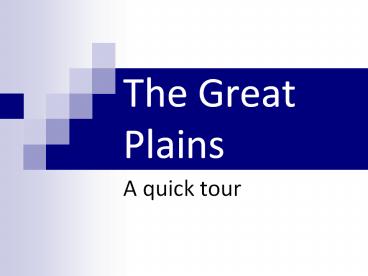The Great Plains - PowerPoint PPT Presentation
Title:
The Great Plains
Description:
The Great Plains A quick tour Location ... Opportunities for land ownership The Homestead Act of 1862. ... Dry Farming & Wheat Farming Dry farming is used in areas ... – PowerPoint PPT presentation
Number of Views:343
Avg rating:3.0/5.0
Title: The Great Plains
1
The Great Plains
- A quick tour
2
Location
- The Great Plains are located just east of the
Rocky Mountains.
3
Physical Features
- Flatlands that rise gradually from east to west.
- Land eroded by wind and water.
- Grasslands with few trees.
4
Climate
- The climate on the Great Plains is very harsh.
- Low rainfall.
- Many dust storms.
- Harsh winters.
5
Before the Civil War
- People referred to the Great Plains as a treeless
wasteland. - Few people settled on the Plains, instead they
passed through on the way west.
6
Scenes from the Plains
7
So, what changed peoples mind?
- Opportunities for land ownership
- The Homestead Act of 1862.
- For a 10 fee, homesteaders got 160 acres of
land. - They had to live on it and farm it for five years
so they could own it. - Technological advances
- Possibility of wealth
- New beginning for former slaves
- Adventure
8
Inventions
Barbed Wire
Windmills
Steel Plows
Railroads
9
Adaptations
Sod Houses
Wheat Farming Dry Farming
Beef Cattle Longhorns
10
Windmills
- A windmill is a machine that is operated by wind
power. Windmills are used chiefly to pump water,
grind grain and generate electric power. - Windmills were used all over The Great Plains.
They were used to pump water from the ground to
the surface so the settlers could use it. This
helped make The Great Plains more livable.
11
Barbed Wire
- The widespread use of barbed wire fences changed
life on the plains. Land that was once open to
all was now being fenced off by ranchers and
homesteaders. Homesteaders were better able to
protect their crops and ranchers had better
control over their herds. The American Indian
was also affected by the wire that they referred
to as Devils rope.
12
Steel Plow
- Invented by John Deere, the steel plow was made
to cut through the tough sod on the Great Plains
without the dirt clogging up along the blade.
This meant the farmer could plow without having
to stop and clean his plow off every few yards.
13
Dry Farming Wheat Farming
- Dry farming is used in areas that have little
rainfall. Basically, the farmer divides his
fields in wide strips and then plants crops on
every other strip. This allows the soil to
gather moisture for two years. - Wheat became popular on The Great Plains because
it actually grows better this way, especially Red
Wheat introduced by Russian Immigrants.
14
Beef Cattle Raising
- Many ranchers started raising beef cattle on the
Great Plains. It actually makes plenty of sense
if you think about itwhat big animal similar to
a cow had been living on the plains for years? - The longhorn was the choice of most as it was
well suited to the harsh climate of the plains.
15
Transcontinental Railroad
- The Transcontinental Railroad connected the
Atlantic and Pacific coasts. It was made up of
many small railroad lines. The railroad opened
up the Great Plains area for people who wanted to
settle there, and made trade easier from one area
of the country to another. This encouraged
industrial growth and economic growth.
16
Sod Houses
- Sod Houses are exactly what they sound like.
Houses made of sod. The settlers used sod
because there were very few trees on the Great
Plains.































